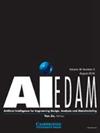人工智能方法在改进创新设计过程中的应用——格构结构案例研究
IF 2.3
3区 工程技术
Q3 COMPUTER SCIENCE, ARTIFICIAL INTELLIGENCE
Ai Edam-Artificial Intelligence for Engineering Design Analysis and Manufacturing
Pub Date : 2022-07-18
DOI:10.1017/S0890060422000051
引用次数: 0
摘要
摘要如今,企业不断寻求方法论方法,以帮助他们减少创新过程所需的时间。在这些方法中,值得一提的是基于TRIZ的框架,如发明设计方法论(IDM),其中使用问题图方法来制定问题。然而,IDM的应用是耗时的,因为需要构建一个完整的地图来澄清问题情况。因此,在IDM框架中引入了逆问题图(IPG)方法,以增强其灵活性。然而,手动收集包括参数和概念在内的基本信息需要努力和时间。本文将神经网络doc2vec和机器学习算法作为人工智能方法集成到受IPG过程启发的图形方法中。这种集成可以通过提取本发明设计过程中的参数和概念来促进和加速本发明解决方案的开发。该方法已被应用于材料领域中开发一种新的晶格结构解决方案。本文章由计算机程序翻译,如有差异,请以英文原文为准。
Artificial intelligence methods for improving the inventive design process, application in lattice structure case study
Abstract Nowadays, firms are constantly looking for methodological approaches that help them to decrease the time needed for the innovation process. Among these approaches, it is worth mentioning the TRIZ-based frameworks such as the Inventive Design Methodology (IDM), where the Problem Graph method is used to formulate a problem. However, the application of IDM is time-consuming due to the construction of a complete map to clarify a problem situation. Therefore, the Inverse Problem Graph (IPG) method has been introduced within the IDM framework to enhance its agility. Nevertheless, the manual gathering of essential information, including parameters and concepts, requires effort and time. This paper integrates the neural network doc2vec and machine learning algorithms as Artificial Intelligence methods into a graphical method inspired by the IPG process. This integration can facilitate and accelerate the development of inventive solutions by extracting parameters and concepts in the inventive design process. The method has been applied to develop a new lattice structure solution in the material field.
求助全文
通过发布文献求助,成功后即可免费获取论文全文。
去求助
来源期刊
CiteScore
4.40
自引率
14.30%
发文量
27
审稿时长
>12 weeks
期刊介绍:
The journal publishes original articles about significant AI theory and applications based on the most up-to-date research in all branches and phases of engineering. Suitable topics include: analysis and evaluation; selection; configuration and design; manufacturing and assembly; and concurrent engineering. Specifically, the journal is interested in the use of AI in planning, design, analysis, simulation, qualitative reasoning, spatial reasoning and graphics, manufacturing, assembly, process planning, scheduling, numerical analysis, optimization, distributed systems, multi-agent applications, cooperation, cognitive modeling, learning and creativity. AI EDAM is also interested in original, major applications of state-of-the-art knowledge-based techniques to important engineering problems.

 求助内容:
求助内容: 应助结果提醒方式:
应助结果提醒方式:


